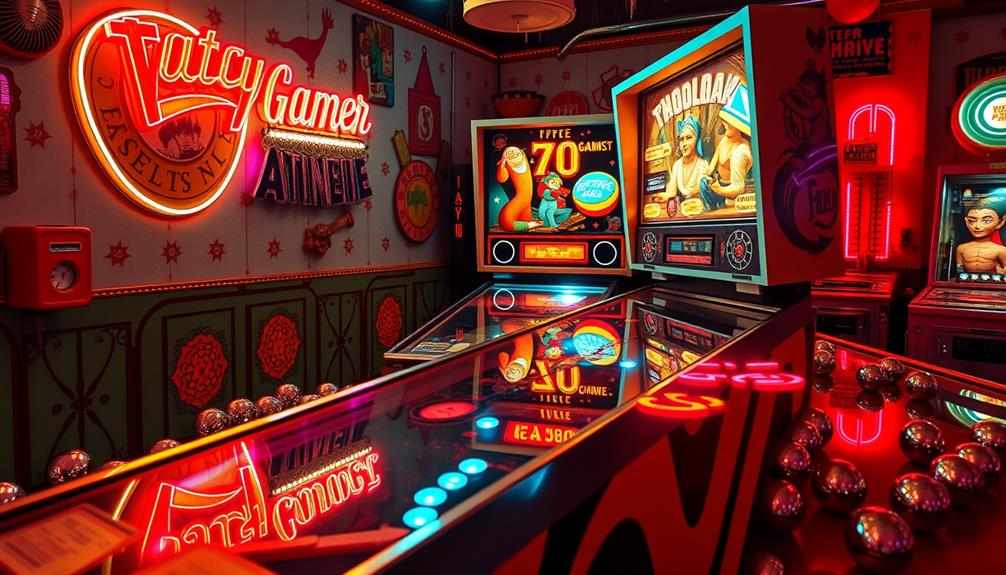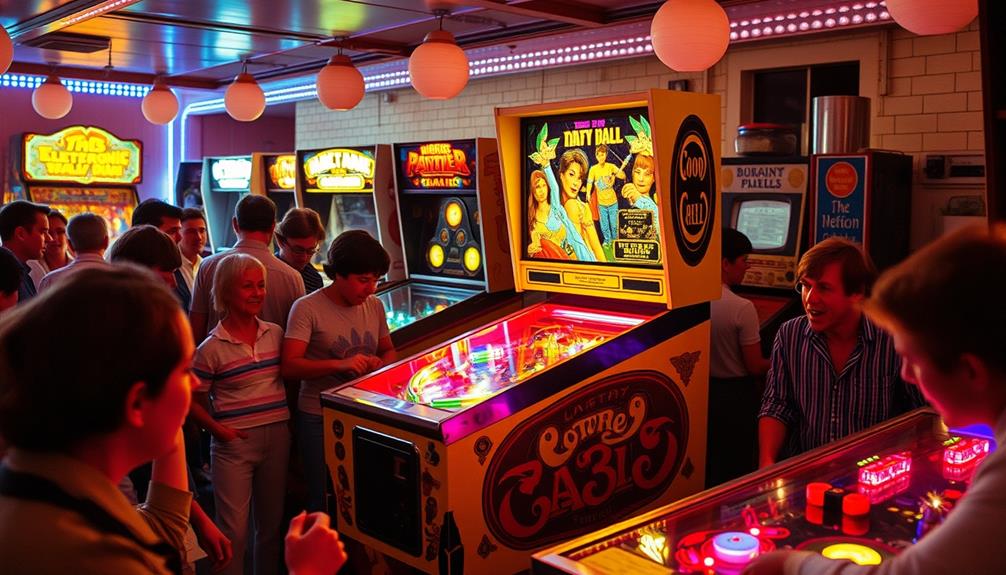The origins of pinball can be traced back to the 18th century with the game Bagatelle. However, it wasn’t until the early 1930s that it evolved into the modern form that we know today. The Whiffle Board, which made its debut in 1931, was the first coin-operated machine, marking the beginning of pinball’s popularity. By 1936, the term “pinball” had become widely recognized. The introduction of bumpers in 1937 and flippers in 1947 shifted the gameplay from being based on luck to being a skill-based competition. If you are curious about how this timeless game has developed over the years, you can discover more intriguing details about its journey.
Key Takeaways
- The origins of pinball trace back to the 18th-century game Bagatelle, focusing on aiming balls into pockets.
- Modern pinball began with the introduction of the Whiffle Board in 1931, marking the first coin-operated machine.
- The term "pinball" was established by 1936, solidifying the game's identity in popular culture.
- Key innovations, like bumpers in 1937 and flippers in 1947, transformed pinball into a skill-based game.
- The Golden Age of Pinball spanned from the late 1940s to early 1960s, showcasing iconic machines and gameplay advancements.
Origins of Pinball
Pinball has its roots in the 18th-century parlor game Bagatelle, where players would aim to hit balls into pockets for points. As you investigate the evolution of this engaging pastime, you'll find that the modern form of pinball started taking shape in the early 1930s. The introduction of the first coin-operated pinball machine, the Whiffle Board, in 1931, marked a significant turning point.
By 1936, the term "pinball" solidified the game's identity, paving the way for its popularity. Understanding the financial aspects of owning such machines is essential, especially when considering things like investment strategies for leisure activities.
The gameplay transformed dramatically with the introduction of bumpers in 1937. These features shifted pinball from being a game of pure luck to one that required skill and strategy, allowing you to influence the ball's movement more effectively.
The real revolution came in 1947 with the addition of flippers, giving players unprecedented control over the ball's trajectory. This innovation not only enhanced gameplay but also added a competitive edge, making pinball a true game of skill.
As you explore the origins of pinball, you can appreciate how these developments laid the foundation for the modern pinball machines you enjoy today.
The First Coin-Operated Machines

The emergence of coin-operated machines in the early 1930s revolutionized gaming, bringing pinball into the spotlight as a popular form of entertainment. The first coin-operated pinball machine, the Whiffle Board, was created in 1931 by Automatic Industries, marking the beginning of modern pinball gaming. These machines were not only fun but also affordable, costing just a penny to play during the Great Depression.
In 1934, Raymond Maloney introduced Ballyhoo, one of the earliest successful coin-operated pinball machines, further cementing pinball's place in popular culture. By 1936, the term "pinball" was officially coined, reflecting the game's growing identity.
Here's a quick look at the early developments in coin-operated pinball machines:
| Year | Machine Name |
|---|---|
| 1931 | Whiffle Board |
| 1934 | Ballyhoo |
| 1936 | Term "Pinball" |
| 1930s | Enhanced Features |
The late 1930s saw the introduction of bumpers and spring-loaded plungers, enhancing player engagement and paving the way for future innovations in coin-operated pinball machines.
Evolution of Gameplay Mechanics
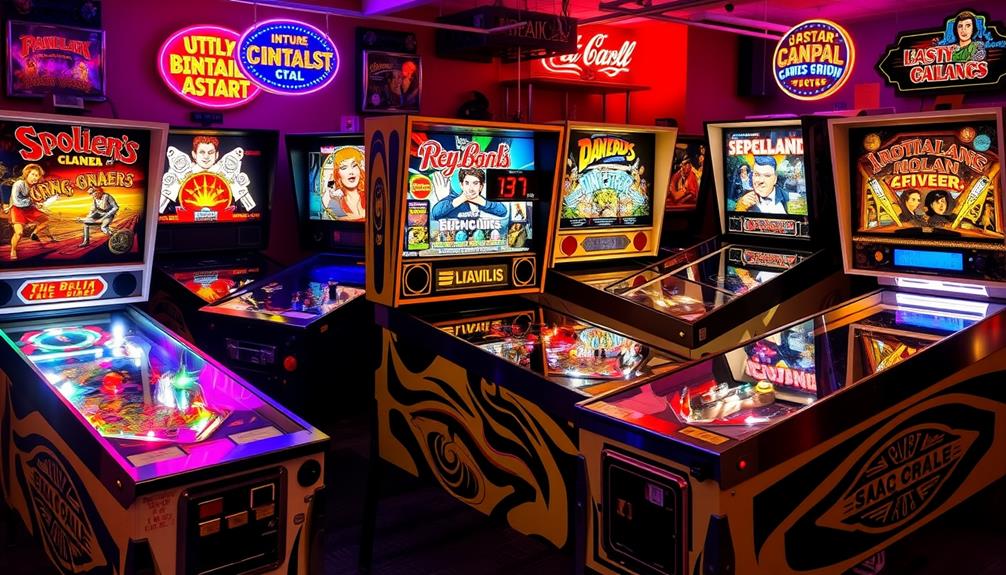
Over the years, gameplay mechanics in pinball have undergone significant transformations, shifting from simple mechanical designs to dynamic, skill-based experiences. Early pinball machines, inspired by a game called Bagatelle, featured basic gameplay that relied heavily on luck.
However, the 1930s introduced electric scoring and sound, enhancing player engagement and feedback. This evolution parallels trends in other entertainment forms, showcasing how innovation drives player interest in activities like astrology and attractiveness.
The advent of flippers in 1947 revolutionized the game, turning pinball from a game of chance into one that required skill and precision. This change marked a pivotal moment in gameplay dynamics.
By the 1960s, multiball gameplay emerged, allowing players to launch multiple balls simultaneously, which added complexity and excitement to the game, boosting scoring opportunities.
The shift from mechanical systems to solid-state electronic technology in the mid-1970s brought forth intricate rule sets and complex gameplay features.
Today, modern pinball machines incorporate advanced technology like LCD screens and interactive elements, creating immersive experiences that captivate a wide audience. As you play, you'll notice how these evolving mechanics provide not just entertainment, but also a challenge that continually engages players in new and exciting ways.
Technological Innovations in Pinball
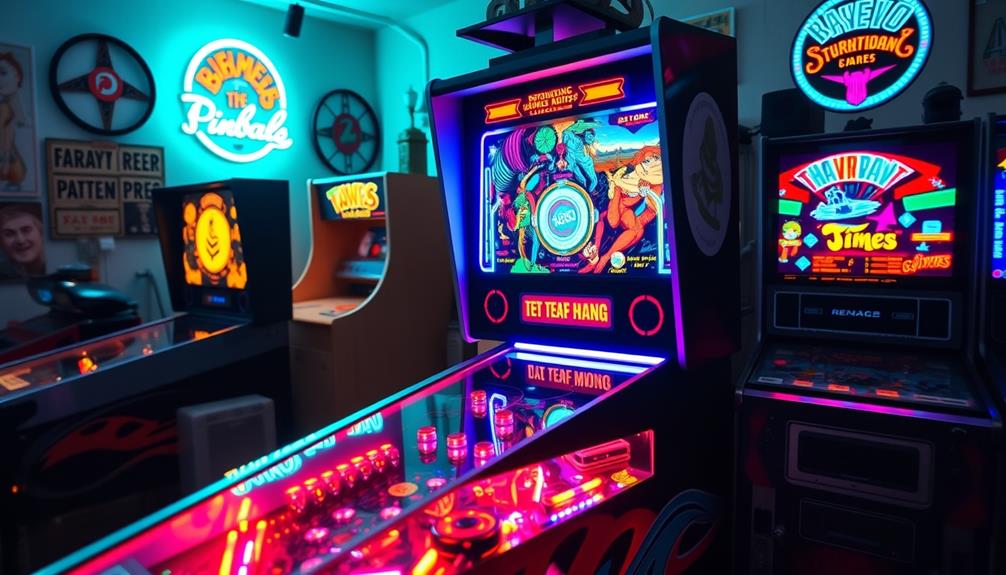
Throughout pinball's history, technological innovations have transformed the game into a fascinating blend of art and engineering. From the early 1933 electrically powered machines with their buzzing sound effects to today's high-tech marvels, the evolution is impressive.
| Year | Innovation |
|---|---|
| 1933 | First electrically powered machine |
| 1937 | Introduction of coil bumpers |
| 1975 | First solid-state electronic machine |
| 2000s | Rise of animatronics and interactive elements |
| Present | Modern machines featuring LED lighting and LCD monitors |
These advancements have notably shaped the pinball industry. The introduction of solid-state electronics in 1975 marked a critical shift, allowing for more complex gameplay. Today, modern machines incorporate LED lighting and immersive themes, drawing in diverse audiences.
Games like Stern Pinball's "Jurassic Park" take player engagement to new heights with interactive elements and animatronics. You'll find that these innovations not only enhance your experience but also keep you coming back for more. As the game continues to evolve, it's exciting to think about what technological innovations lie ahead for pinball enthusiasts.
The Impact of World War II

World War II drastically impacted pinball production, as manufacturers shifted to support the war effort, creating a scarcity of machines.
This disruption in production also mirrored the broader shifts in consumer behavior, reflecting the need for data-driven strategies to adapt to changing times.
After the war, you'd see a resurgence in pinball's popularity, fueled by returning soldiers seeking leisure activities.
However, pinball also faced challenges from gambling perceptions and bans, which shaped its cultural landscape during that time.
Manufacturing Resurgence Post-War
The end of World War II sparked a remarkable revival in pinball manufacturing, as companies raced to meet the surging demand for entertainment in bars and amusement venues. With a growing post-war economy, people sought leisure activities, and pinball machines became a popular choice. This surge in interest paralleled the rise of other entertainment options, such as coffee culture, where unique brewing methods like French press coffee offered new experiences for enthusiasts.
The introduction of flippers in 1947 transformed the game, shifting it from pure chance to one that required skill, greatly boosting its popularity.
By the late 1940s, manufacturers like Gottlieb, Williams, and Bally sprang up, enthusiastic to capitalize on this new trend. This era witnessed a wave of innovation, introducing features like match bonuses and moving targets that enhanced gameplay and attracted a broader audience. As you played, you could now employ strategy and skill, making each game more engaging.
Pinball quickly became a staple of American arcade culture in the 1950s, with machines popping up in various venues across the nation. The combination of increased leisure time and a revived economy allowed pinball to thrive, cementing its place in the hearts of many.
As you immersed yourself in the flashing lights and sounds, you were part of a booming entertainment phenomenon.
Gambling Perceptions and Bans
In the 1940s, pinball machines faced a significant backlash as they were often labeled as gambling devices, leading to widespread bans in major U.S. cities. Concerns over juvenile delinquency and connections to organized crime fueled this negative public perception.
In 1942, New York City Mayor Fiorello LaGuardia spearheaded a crackdown on these machines, confiscating over 2,000 of them, which were then repurposed for war efforts. The stigma surrounding pinball was akin to the fears associated with cold medications overview during that time, highlighting societal concerns about perceived vices and their effects on the public.
Civic groups, law enforcement, and churches rallied against pinball, arguing that it corrupted youth and exacerbated urban crime. The media sensationalized these claims, further stigmatizing the game and prompting government action to eliminate pinball from public spaces.
As a result, legislative actions against pinball included harsh penalties such as fines and machine confiscation. Public destruction of machines symbolized the government's commitment to combating what many perceived as a societal vice.
These bans not only reflected a moral panic but also reshaped the landscape of entertainment during and after World War II, leaving a lasting impact on pinball's reputation and accessibility for years to come.
The Golden Age of Pinball
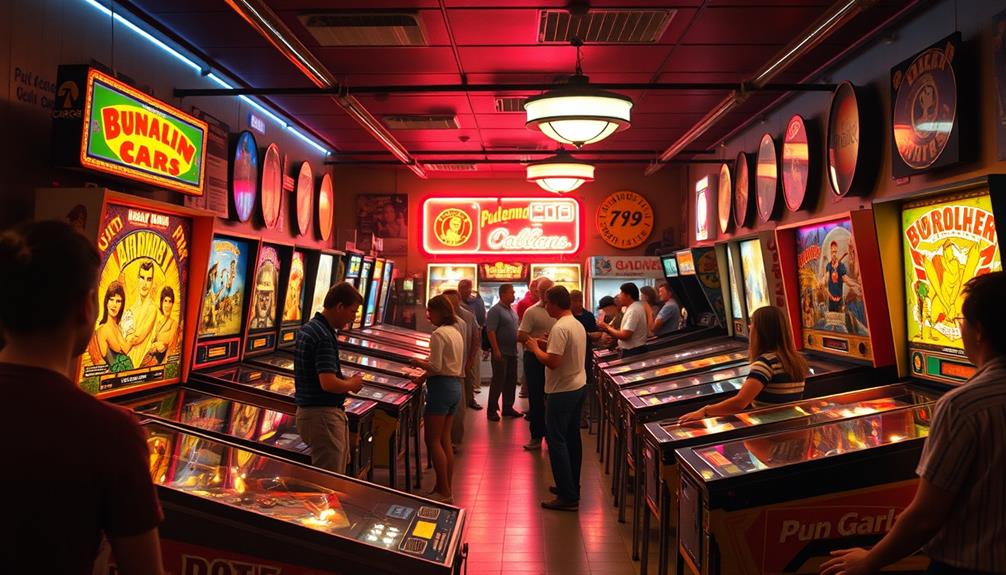
Pinball experienced a remarkable transformation during its Golden Age, which spanned from the late 1940s to the early 1960s. This era introduced the modern flipper, shifting pinball from a game of chance to a game of skill. You could now actively engage with the gameplay mechanics, making each game feel more rewarding and strategic.
The new flipper arrangement and features like match bonuses and moving targets greatly enhanced player involvement and enjoyment. Additionally, the rise of pinball machines paralleled the increasing popularity of celebrity culture, as machines often featured themes that resonated with the public, showcasing celebrity lifestyle insights.
During this time, iconic machines such as Bally's "Humpty Dumpty" and "Triple Action" emerged, setting the stage for future designs. These machines didn't just entertain; they solidified pinball's place in arcade culture. As you played, the thrill of achieving high scores and mastering complex gameplay mechanics became integral to the experience.
Despite its rising popularity, pinball faced challenges, especially due to its association with gambling. Many cities enacted bans, creating a cultural stigma around the game.
Nevertheless, the Golden Age of Pinball laid the groundwork for the beloved pastime you enjoy today, blending skill, strategy, and entertainment in a way that continues to captivate players.
Legal Challenges and Bans
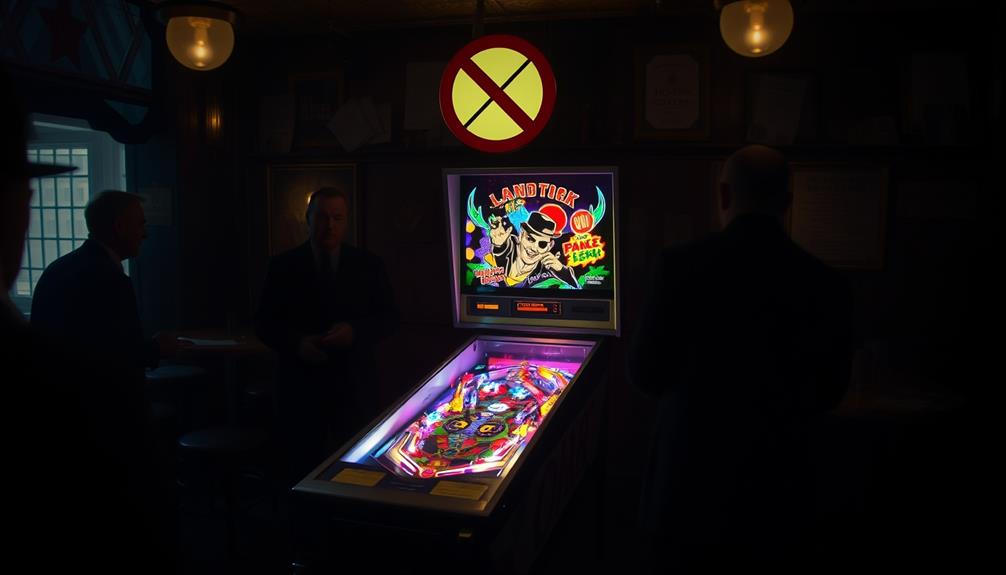
When you think about pinball's history, it's hard to ignore the legal challenges it faced. Cities like New York and Chicago enacted bans due to fears about gambling and its impact on youth.
These restrictions sparked legal battles that ultimately changed how pinball was classified and perceived. The push for regulation was partly fueled by concerns similar to those seen in mental health discussions, where societal pressures can shape stigma and misunderstanding, particularly regarding activities associated with risk and impulsivity, such as impulsive behaviors.
Gambling Perceptions and Concerns
Throughout the 1940s, many cities across the U.S. faced significant legal challenges regarding pinball machines, often viewing them as gambling devices. This perception led to widespread bans in cities, especially in New York City, where Mayor Fiorello LaGuardia spearheaded a crackdown in 1942. His efforts culminated in the confiscation of over 2,000 machines, which were repurposed for war efforts.
The media sensationalized pinball's association with juvenile delinquency, fueling public opposition and campaigns by civic leaders to eliminate these machines. This scenario mirrors the dynamics often seen in relationships with narcissists, where public perceptions can lead to stigmatization and misunderstanding, as highlighted in the discussion about narcissistic behavior and relationships.
In 1950, the Johnson Act complicated the industry's legal status by prohibiting the interstate shipping of pinball machines deemed to be gambling devices. The stigma surrounding pinball persisted until a pivotal moment in 1974 when the California Supreme Court ruled pinball a game of skill.
This ruling opened the door for the legalization of pinball in various states and eventually led to the lifting of bans in cities like New York. The shift in perception from gambling devices to games of skill dramatically changed the landscape for pinball, allowing it to flourish and evolve into the beloved pastime it's today.
City-Wide Bans Enacted
In the early 1940s, city officials across the United States took decisive action against pinball machines, enacting widespread bans fueled by moral outrage and fears of juvenile delinquency.
New York City Mayor Fiorello LaGuardia led the charge in 1942, citing moral concerns and confiscating over 2,000 machines for repurposing metal during World War II. Cities like Milwaukee, Chicago, New Orleans, and Los Angeles quickly followed suit, viewing banned pinball as a gateway to gambling and a corrupting influence on children.
The situation was exacerbated by financial implications in divorce, as many families faced economic strain during this period, leading to increased scrutiny of leisure activities like pinball.
Public campaigns by law enforcement, civic groups, and churches intensified efforts to eliminate these machines from entertainment venues. The media sensationalized pinball's association with delinquency, further shaping negative public sentiment and framing pinball as a vice during the 1940s and 1950s.
This perception of pinball machines as dangerous persisted for decades.
However, a turning point came in 1974 when the California Supreme Court ruled pinball a game of skill. This landmark decision sparked efforts to legalize pinball, paving the way for gradual legalization across various states.
The history of pinball machines took a significant turn, moving from widespread bans to acceptance in society.
Legal Battles Over Classification
Legal battles over the classification of pinball machines greatly shaped their fate in America. From the 1940s to the 1970s, fears surrounding gambling and juvenile delinquency led to widespread pinball bans. New York City Mayor Fiorello LaGuardia even ordered the destruction of over 2,000 machines in 1942, associating them with organized crime.
These legal disputes echoed broader societal concerns about existential themes and the moral implications of leisure activities.
Key legal battles emerged to determine whether pinball was a game of skill or a game of chance. Notable moments include:
- 1942 Crackdown: LaGuardia's aggressive campaign against pinball machines.
- California Supreme Court Ruling (1974): This pivotal decision classified pinball as a game of skill.
- Demonstrations: Public events showcased the skill involved, influencing the lifting of bans.
- New York City Ban Lift (1976): After years of restrictions, the city finally recognized the game's potential for revenue.
These legal challenges not only changed public perception but also paved the way for pinball's resurgence. The shift in classification was essential in dispelling myths surrounding pinball and allowed it to thrive once again, free from the stigma of gambling and delinquency.
The Pinball Revival
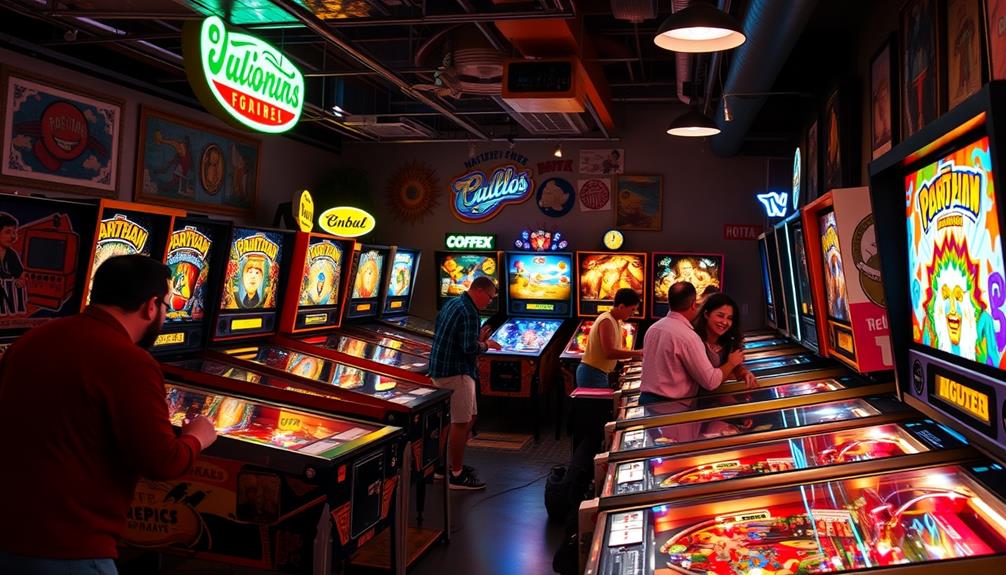
Amid the digital gaming boom, the late 1990s and early 2000s sparked a pinball revival as enthusiasts rallied to celebrate and preserve classic machines. You might've noticed this resurgence brought together a community driven by competitive interest and a love for this nostalgic form of entertainment.
Modern manufacturers like Stern Pinball and Jersey Jack Pinball stepped in, introducing innovative machines that utilize advanced technology and feature immersive themes from popular franchises. This creativity not only rejuvenated interest in pinball but also made it relevant for a new generation of players.
Here's a snapshot of the pinball revival:
| Aspect | Details |
|---|---|
| Pinball Tournaments | Over 1,800 held annually |
| Manufacturers | Stern Pinball, Jersey Jack Pinball |
| Community Events | Pinball shows and conventions |
| Nostalgia Factor | Resurgence of retro gaming culture |
Pinball shows and events have become essential for community engagement, showcasing new designs and ensuring the spirit of pinball remains vibrant. So, whether you're a seasoned player or a newcomer, there's never been a better time to plunge into the world of pinball!
Future of Pinball Machines
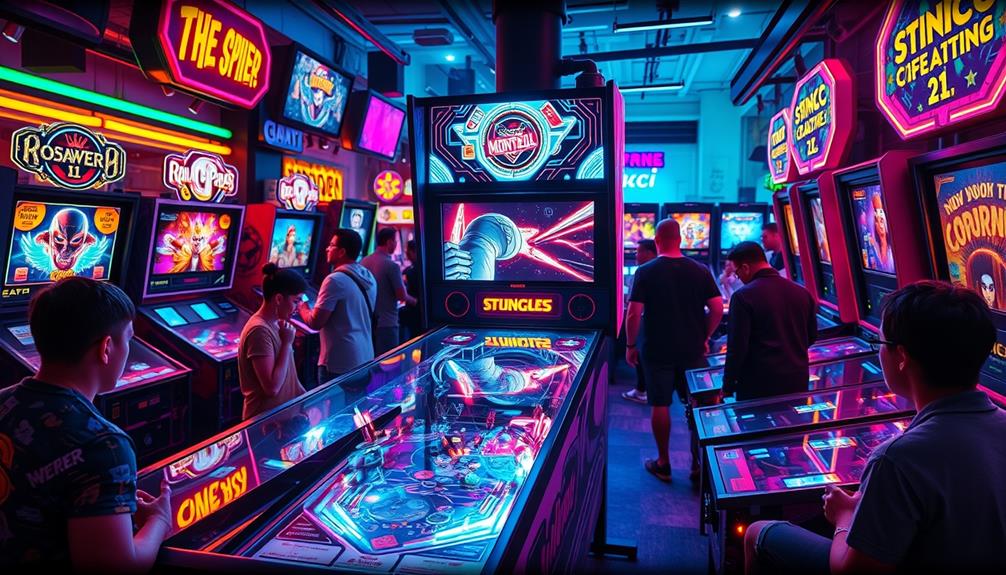
As technology continues to evolve, the future of pinball machines looks promising, with exciting advancements set to enhance the gameplay experience.
The combination of nostalgia and innovation is driving a resurgence in interest, ensuring pinball's place in both arcade and home gaming environments.
Here are some key trends shaping the future of pinball machines:
- Technological Advancements: Expect more machines featuring LED lighting and LCD monitors, creating immersive experiences and vibrant visuals.
- Retro Gaming Appeal: The interest in retro gaming means new machines will often pay homage to classic designs while integrating modern tech.
- Themed Collaborations: Manufacturers are collaborating with popular franchises, attracting diverse audiences and leveraging established fan bases to create engaging experiences.
- Growing Pinball Culture: With over 1,800 pinball tournaments held annually, the community is thriving, fostering a vibrant pinball culture that encourages participation and competition.
As you explore the future of pinball machines, you'll see a blend of tradition and innovation, keeping the spirit of this beloved game alive for generations to come.
Frequently Asked Questions
When Did Pinball Become Popular?
Pinball became popular during the Great Depression in the 1930s, especially after the introduction of coin-operated machines. The addition of flippers in 1947 further enhanced its appeal, solidifying its status in bars and arcades.
Was Pinball Popular in the 70S?
Imagine walking into an arcade in the 70s, hearing the clatter of pinballs. Yes, pinball exploded in popularity then, especially after iconic machines like "Gorgar" captivated players and transformed how you experience gaming.
Why Was Pinball Illegal in the USA?
Pinball was illegal in the U.S. due to fears of gambling and juvenile delinquency. Critics linked it to organized crime, prompting bans and crackdowns, especially in cities like New York during the mid-20th century.
What Was the First Licensed Pinball Machine?
Imagine discovering a treasure chest in a game; that's what players felt when "The Wizard" debuted in 1975. It was the first licensed pinball machine, blending enchanting themes and innovative gameplay, forever changing the industry.
Conclusion
In the ever-evolving game of pinball, you've witnessed a journey from its humble origins to its vibrant revival today. Just like a well-timed flipper, pinball's resilience keeps it bouncing back, enchanting new generations. Whether you're chasing high scores or reliving nostalgia, each tilt of the machine echoes the thrill of the past. So, let the silver balls roll and embrace the magic of pinball, where every game tells a story waiting for you to explore.
